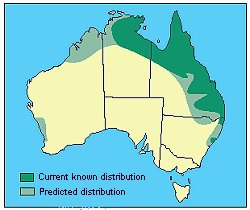Introduced Species


Impact
The arrival of the cane toad has resulted in wide-spread disaster on the areas of the park it has reached so far and has exploited a feeling of dread for the future of the park’s biodiversity. The toad is expected to decimate populations of native animals in the world famous park over the next few years. Two particularly susceptible species to the toad are the northern Quoll and northern bandicoots which have declined at an alarming rate.
There are many impacts or effects that the cane toads are expected to have on the park. These include effects on predator species, prey species, resource competition, cultural effects, economic effects, and more. A total of 151 species or species groups have been classified susceptible to cane toads.
The cane toad has also, and will continue to, impact Aboriginal Communities. The major impacts on these communities within
The cane toad has been such an unstoppable inhabitant for many reasons. It has thrived on available food such as other frogs, small lizards, mice, birds, fish, insects, and sometimes even young cane toads. It needs little water for breeding, with the female toad producing up to 40 000 eggs a month. Eggs hatch in three days and rapidly develop from tadpoles to toadlets. The cane toad has virtually no predators, thanks to its highly toxic chemical-secreting glands. The warm, moist conditions of large areas of northern
Some wildlife groups have initiated a cane toad identification training program and rapid response strategy to manage human assisted incursions of cane toads. Additionally, frog recording stations have been established at four sites in Kakadu (and more are planned). Baseline data have been collected for the past two Wet seasons.
There have also been major efforts buy wildlife rescue and land conservation groups who have caught the frogs, single-handed, and have eradicated them. These efforts have been worthwhile, despite the ever-growing population of toads.
Mimosa
The mimosa plant or Mimosa Pigra is an invasive weed that was introduced to
A single Mimosa plant can produce over two hundred thousand seeds each year, and the seed pods float, enabling them to spread rapidly during the wet.
Solutions
Experiments have also shown that mechanical control rarely kills the plants. Healthy Mimosa is difficult to burn and the plants usually re-sprout. The goal now is to find more determined or resilient insects.


Salvinia
Impact
Salvinia has a phenomenal growth rate, doubling its dry weight in two and a half days when conditions are right. This makes it particularly dangerous as an invasive weed. A Salvinia infestation can reach up to 400 tonnes of wet weight per hectare.
- a weevil (Cyrtobagous salviniae)
- a moth (Samea multiplicalis)
- a grasshopper (Paulinia acuminata).
The weevil was the most successful of the three and managed to decrease the weed to a small amount in many seriously impacted areas.
A combination of chemical and biological controls are also in place to try and prevent the weed from spreading.
Weevil (Cyrtobagous salviniae)
A biological control agent, a species of weevil, Cyrtobagous salviniae, was introduced shortly after the discovery of the Salvinia plant. This weevil controls the plant for most years but at the end of the dry season, when the weevil has consumed most of the Salvinia, its population rapidly decreases. However, in the wet season, the high nutrient levels cause the Salvinia to grow faster than the weevil population can regenerate.
The feral water buffalo (Bubalus bubalis)
Water buffalos were imported to
Impact
The buffalos have been a major environmental disaster in the wetlands of Kakadu. They have destroyed countless wetland areas (particularly billabongs) and have reduced large areas to floodplains. They have also introduced diseases that have affected native species and livestock.
Leaving wallows, trails, trampling and disturbance, it caused soil erosion, channeling of floodwaters, increased intrusion of saltwater into freshwater habitats and destruction of wetland vegetation. Many of the native wetland flora and fauna failed to thrive in muddied or salt polluted water. The buffalos eat large volumes of grass and other plants, removing this food source for the native wildlife, and they can damage trees they regularly rub against. The buffalos also carry diseases of cattle including tuberculosis and brucellosis.
Solutions
Fortunately, the problem of the feral water buffalo has already been elimated to a safe degree. This is due to a massive shooting program that was part of the tuberculosis and brucellosis Eradication Campaign from 1979 to 1997. The buffalos were shot from helicopters as the difficult terrain made full eradication impossible. Due to this program the numbers of buffalo has decreased dramatically from around 350 000 in the 1980s to 20 000 in 1988 to under 250 in 1996.
The

Helpful introduced Species
Although there have been many introduced species that have had a negative impact on the park, there has been one species introduced that has, in fact, had a positive effect. Leuciris fimbriaria is a species of moth, originated from
by Kate Walker